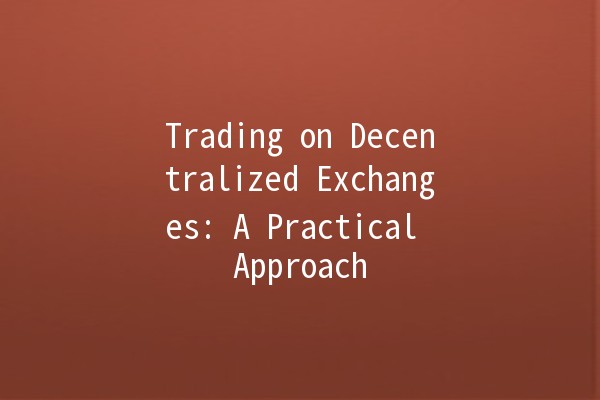
Decentralized exchanges (DEXs) have transformed the landscape of digital trading, allowing users to trade cryptocurrencies directly with each other. This shift has empowered traders by removing the middlemen, enhancing privacy, and facilitating a broader range of transactions. In this article, we will explore the practical aspects of trading on decentralized exchanges, providing actionable tips and strategies to optimize your trading experience.
Understanding Decentralized Exchanges

What is a Decentralized Exchange?
A decentralized exchange (DEX) is a platform that enables the trading of cryptocurrencies without the need for a centralized authority. Unlike traditional exchanges, which rely on a central server to execute trades and hold customer funds, DEXs operate on blockchain technology, using smart contracts to facilitate transactions directly between users.
Key Features of DEXs
Popular Decentralized Exchanges
Uniswap: A leading DEX known for its automated liquidity provision.
Sushiswap: A communitydriven DEX that offers enhanced features for users.
PancakeSwap: Built on the Binance Smart Chain, it provides a lowfee trading experience.
Tips for Trading on Decentralized Exchanges
Explanation
Every decentralized exchange has its unique features, supported tokens, and fee structures. Selecting the right platform is crucial for an efficient trading experience.
Application Example
If you are looking to trade Ethereumbased tokens, Uniswap may be your best option due to its large liquidity pool. For Binance Smart Chain tokens, consider PancakeSwap for lower transaction fees.
Explanation
To trade on a DEX, you need a secure wallet that supports the tokens you're interested in. Wallets can be hardwarebased (cold wallets) or softwarebased (hot wallets).
Application Example
MetaMask is a popular choice for Ethereum and ERC20 tokens, allowing easy integration with platforms like Uniswap. For Binance Smart Chain, you could use Trust Wallet.
Explanation
Most DEXs operate on an AMM model, where liquidity is provided by users who deposit their assets into liquidity pools. Understanding how these systems work can help you make better trading decisions.
Application Example
When trading on Uniswap, you might notice that prices can fluctuate based on the available liquidity in the pool. Keeping an eye on this can help you avoid higher slippage costs.
Explanation
While many DEXs initially did not support limit orders, some newer platforms incorporate this feature. Using limit orders can help traders enter positions at desired price points.
Application Example
If you want to buy a token at a specific price, placing a limit order ensures you won’t purchase at a higher price due to instantaneous market fluctuations.
Explanation
Transaction fees (gas fees) can vary significantly on the Ethereum network, especially during peak times. Being mindful of fees can improve your trading outcomes.
Application Example
Before executing a trade, check the current gas fees using a site like Etherscan. You may choose to wait for lower fees if the price difference justifies the delay.
Common Challenges in Trading on DEXs
Decentralized exchanges are prone to high volatility due to lower liquidity and the rapid pace of change in the crypto market. Traders must be prepared for significant price swings.
For newcomers, the technical aspects of setting up wallets, connecting to DEXs, and understanding AMMs can be daunting. Familiarizing oneself through practice is essential.
While DEXs themselves are generally secure due to their decentralized nature, the wallets and smart contracts can be vulnerable. Always ensure the contract you are interacting with is audited and reputable.
Frequently Asked Questions
Decentralized exchanges allow peertopeer trading without intermediaries, whereas centralized exchanges act as intermediaries, holding funds and executing trades on behalf of users.
Utilizing hardware wallets provides a layer of security. Avoid sharing your private keys and always doublecheck the URLs of the platforms you are using to prevent phishing attacks.
Yes! Many DEXs offer liquidity provision programs, where you can earn a share of transaction fees by depositing your assets into liquidity pools.
Not all tokens are available on DEXs. Listing can vary between platforms, and some new projects may initially only launch on DEXs before appearing on centralized exchanges.
Impermanent loss occurs when you provide liquidity to a pool and the price of the deposited tokens changes relative to when they were added to the pool. Understand the risks before providing liquidity.
Slippage is calculated as the difference between the expected price of a trade and the actual price at which the trade is executed. Always set slippage tolerance parameters when trading, especially during high volatility.
Trading on decentralized exchanges presents both opportunities and challenges. By following the tips outlined above, you can enhance your trading experience, minimize risks, and tap into the exciting world of decentralized finance. As the ecosystem evolves, continuous learning and adaptation will be key to optimizing your strategy and securing your digital assets. Happy trading! 🎉

